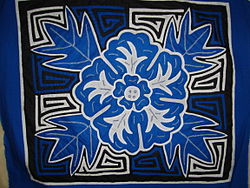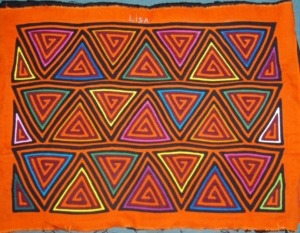 Molas are part of traditional costumes worn by Kuna women, four mola panels are formed into the front and back panels of a blouse. The full costume traditionally includes a patterned wrapped skirt (saburet), a red and yellow headscarf (musue), arm and leg beads (wini), a gold nose ring (olasu) and earrings in addition to the mola blouse (dulemor). In Dulegaya, the Kuna’s native language, “mola” means “shirt” or “clothing”.
Molas are part of traditional costumes worn by Kuna women, four mola panels are formed into the front and back panels of a blouse. The full costume traditionally includes a patterned wrapped skirt (saburet), a red and yellow headscarf (musue), arm and leg beads (wini), a gold nose ring (olasu) and earrings in addition to the mola blouse (dulemor). In Dulegaya, the Kuna’s native language, “mola” means “shirt” or “clothing”.
Molas originated with the art of body painting; before the colonization of Panama
 Today molas are still all made by hand using a reverse appliqué technique. Several layers of different-coloured cloth are sewn together; the design is then formed by cutting away parts of each layer. The edges of the layers are then turned under and sewn down, often times the stitches are nearly invisible. This is achieved by using a thread the same color as the layer being sewn, sewing blind stitches, and sewing tiny stitches. The largest pattern is typically cut from the top layer, and progressively smaller patterns from each subsequent layer, revealing the colours beneath.Kuna women painted geometrical designs on their bodies using the colors naturally found. After colonization cloth was easily accessible and Kuna women began first by painting directly on the fabric and later by using the technique of reverse application. Some of the oldest molas are between 150 and 170 years old. In the past 50 years, they also started to depict realistic and abstract designs of flowers, sea animals and birds. However, the much more traditional geometric designs are still widely produced. Traditions surrounding molas very island to island but often times Kuna women begin with the crafting of molas after they reach puberty.
Today molas are still all made by hand using a reverse appliqué technique. Several layers of different-coloured cloth are sewn together; the design is then formed by cutting away parts of each layer. The edges of the layers are then turned under and sewn down, often times the stitches are nearly invisible. This is achieved by using a thread the same color as the layer being sewn, sewing blind stitches, and sewing tiny stitches. The largest pattern is typically cut from the top layer, and progressively smaller patterns from each subsequent layer, revealing the colours beneath.Kuna women painted geometrical designs on their bodies using the colors naturally found. After colonization cloth was easily accessible and Kuna women began first by painting directly on the fabric and later by using the technique of reverse application. Some of the oldest molas are between 150 and 170 years old. In the past 50 years, they also started to depict realistic and abstract designs of flowers, sea animals and birds. However, the much more traditional geometric designs are still widely produced. Traditions surrounding molas very island to island but often times Kuna women begin with the crafting of molas after they reach puberty.
Molas have changed and diversified over the years, reflecting Kuna culture as well as the modern world. Geometric molas are the most traditional, having developed from ancient body painting designs. Many hours of careful sewing are required to create a fine mola. The ability to make an outstanding mola is a source of status among Kuna women. It can take up to six months for some molas to be completed.
If you want to learn more about the art of making molas consider our Learn Spanish & Visit the Islands Package, a week long Intensive Spanish course that includes a room in a hostel here in Casco Viejo and a weekend trip to the San Blas Islands.
